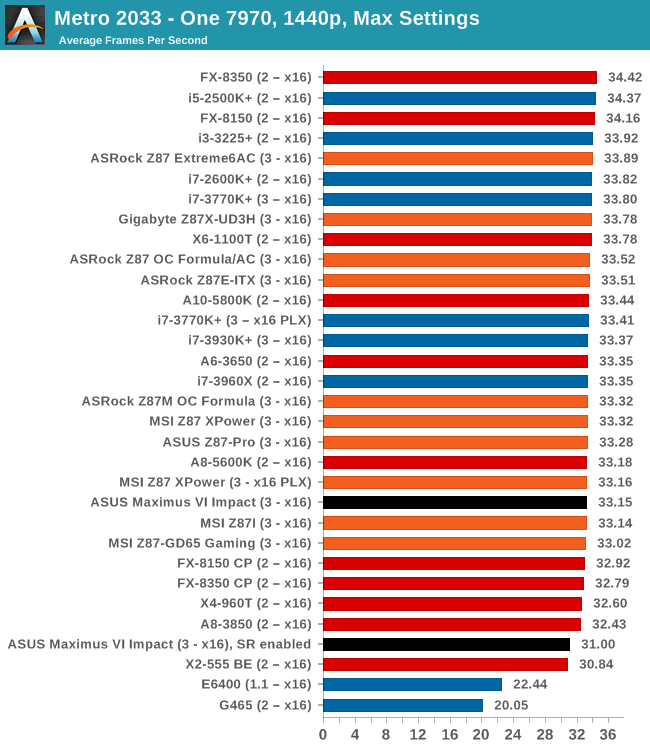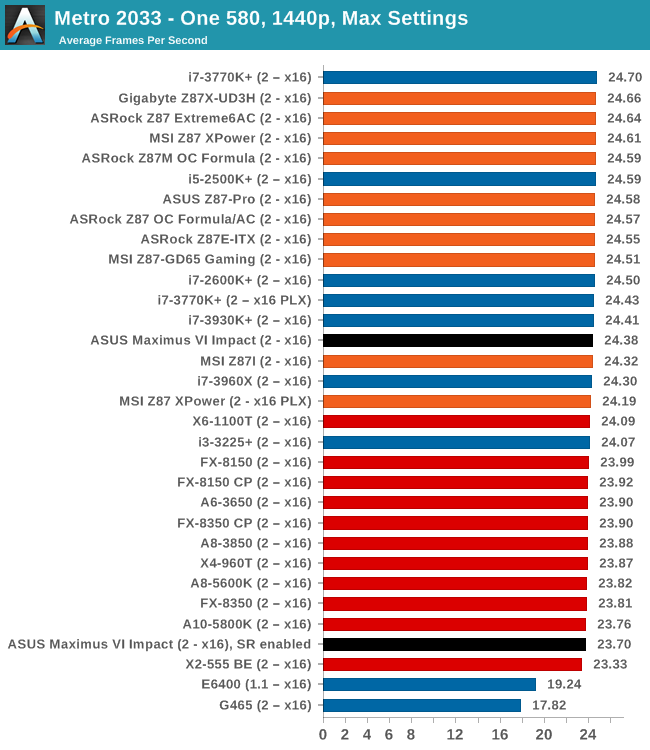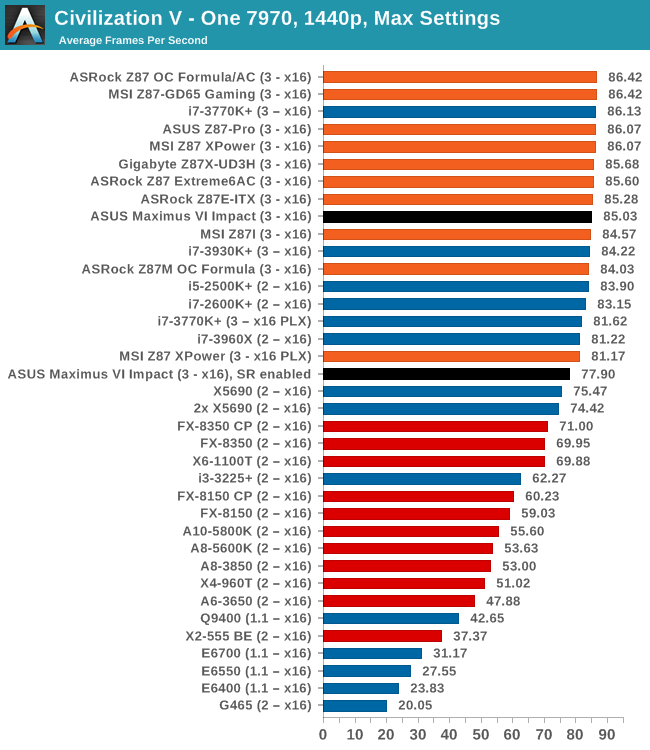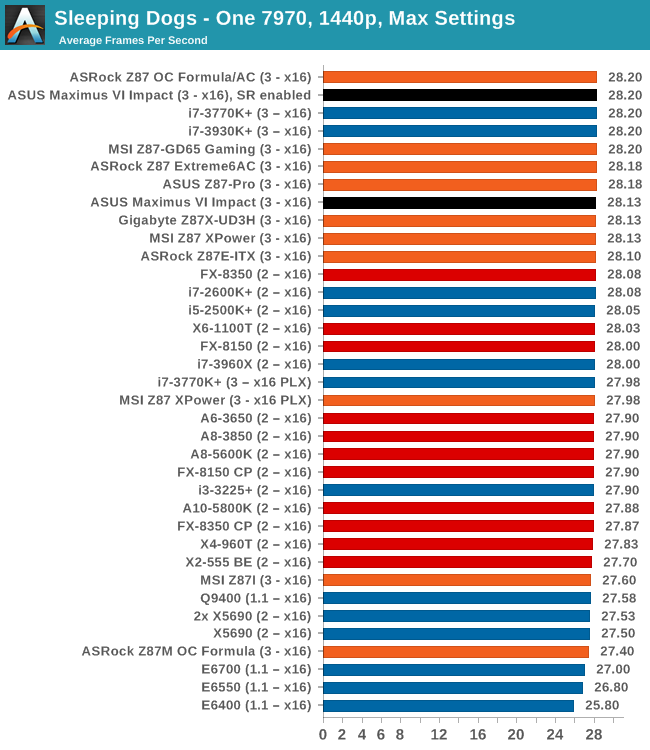ASUS Maximus VI Impact Review: ROG and Mini-ITX
by Ian Cutress on November 22, 2013 10:00 AM ESTGaming Benchmarks
While writing this review and inputting the benchmark numbers into my custom database, I came across a significant discrepancy in the gaming benchmark performance of the Impact against other motherboards in three out of four of our gaming tests. In our testing configurations, we saw a 2 FPS dip against other Z87 motherboards. The culprit it seems is Sonic Radar, the new software designed to aid gamers with a visual representation of directional audio. To put this into perspective, this is what I saw in my testing with Metro 2033:
Settings: 1440p, max everything. CPU at stock, XMP enabled, benchmark mode.
With Sonic Radar enabled, 31.00 FPS and the following frame rate graph:
Without Sonic Radar enabled, 33.15 FPS and the following frame rate graph:
Now it is painfully obvious that the FPS graph with Sonic Radar is manic. Regular fluctuations up to 300 FPS are noticeable at this level of gameplay, whereas it was not noticeable in Dirt 3. This is the first generation of Sonic Radar release, and I am conversing with ASUS whether there is something fundamental with Sonic Radar, or my system setup, that is causing this affect. I have put both SR and non-SR numbers in the benchmark results below.
Metro2033
Our first analysis is with the perennial reviewers’ favorite, Metro2033. It occurs in a lot of reviews for a couple of reasons – it has a very easy to use benchmark GUI that anyone can use, and it is often very GPU limited, at least in single GPU mode. Metro2033 is a strenuous DX11 benchmark that can challenge most systems that try to run it at any high-end settings. Developed by 4A Games and released in March 2010, we use the inbuilt DirectX 11 Frontline benchmark to test the hardware at 1440p with full graphical settings. Results are given as the average frame rate from a second batch of 4 runs, as Metro has a tendency to inflate the scores for the first batch by up to 5%.


Dirt 3
Dirt 3 is a rallying video game and the third in the Dirt series of the Colin McRae Rally series, developed and published by Codemasters. Dirt 3 also falls under the list of ‘games with a handy benchmark mode’. In previous testing, Dirt 3 has always seemed to love cores, memory, GPUs, PCIe lane bandwidth, everything. The small issue with Dirt 3 is that depending on the benchmark mode tested, the benchmark launcher is not indicative of game play per se, citing numbers higher than actually observed. Despite this, the benchmark mode also includes an element of uncertainty, by actually driving a race, rather than a predetermined sequence of events such as Metro 2033. This in essence should make the benchmark more variable, but we take repeated in order to smooth this out. Using the benchmark mode, Dirt 3 is run at 1440p with Ultra graphical settings. Results are reported as the average frame rate across four runs.


Civilization V
A game that has plagued my testing over the past twelve months is Civilization V. Being on the older 12.3 Catalyst drivers were somewhat of a nightmare, giving no scaling, and as a result I dropped it from my test suite after only a couple of reviews. With the later drivers used for this review, the situation has improved but only slightly, as you will see below. Civilization V seems to run into a scaling bottleneck very early on, and any additional GPU allocation only causes worse performance.
Our Civilization V testing uses Ryan’s GPU benchmark test all wrapped up in a neat batch file. We test at 1080p, and report the average frame rate of a 5 minute test.


Sleeping Dogs
While not necessarily a game on everybody’s lips, Sleeping Dogs is a strenuous game with a pretty hardcore benchmark that scales well with additional GPU power due to its SSAA implementation. The team over at Adrenaline.com.br is supreme for making an easy to use benchmark GUI, allowing a numpty like me to charge ahead with a set of four 1440p runs with maximum graphical settings.














69 Comments
View All Comments
Morawka - Saturday, November 23, 2013 - link
it's ATA Secure. Every nand chip in the ssd gets cleared out by writing zeroes to the entire drive.Gigaplex - Monday, November 25, 2013 - link
That's not necessarily how it works, especially for SandForce based controllers.colinisation - Friday, November 22, 2013 - link
Could you test out an M2 SSD in the MPCie Combo card slot, I am interested to see if it chokes the SSD?Mr Perfect - Friday, November 22, 2013 - link
Two questions about the overview on page one.First, what is the difference between using the FastBoot jumper to toggle between UEFI booting methodology and the legacy boot sequence? Under what circumstances would you want to use an older, slower boot method?
Second, the top right button on the "Impact Control" board is labeled as Clear CMOS, but the paragraph under the picture describes it as a USB BIOS Flashback button. Is this a dual function button, or am I missing something?
DanNeely - Friday, November 22, 2013 - link
Using an obsolete OS *cough*Windows XP*cough* that doesn't support UEFI would be an obvious example.Some people in OSS land have a massive hateon for UEFI because it's much more heavily controlled and patent encumbered by Intel and might refuse to use it for ideological reasons.
Morawka - Saturday, November 23, 2013 - link
First: When Using Liquid Nitrogen to OverclockSecond: No it's a error. USB Bios Flashback button is found on the i/O shield and the usb stick must be in the designated port.
Mr Perfect - Monday, November 25, 2013 - link
Hmm, okay, thanks.martixy - Friday, November 22, 2013 - link
That moment when you discover a whole new dimension just waiting for you to play in!creed3020 - Friday, November 22, 2013 - link
Thanks so much for the review Ian! I have been waiting for this review since the ASUS Z87 lineup launched. I was floored that a mini-ITX board was joining the ROG lineup. I'm hoping for my new build to be centered around this board.Arbie - Friday, November 22, 2013 - link
It's simply amazing that one can buy this much engineering, fabrication, and quality for $225.